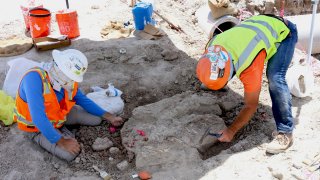
Paleontologists excavate fossils found during construction of SR-11/Otay Mesa East.
Millions-year-old fossils were discovered amid construction of a new toll road and border crossing near Otay Mesa, uncovering what could be the first sign of a 16-million-year-old geologic formation in Southern California.
The bones of a now-extinct species of ancient camel and an oreodont, a plant-eater about the size of a goat -- along with a multitude of other small mammal and plant fossils, and even a volcanic bomb -- were discovered as paleontologists with the San Diego Museum of Natural History (NAT) monitored the SR-11/Otay Mesa East construction project near the U.S.-Mexico Border.
The fossils could be up to 28 million years old.
But even more significant, the paleontologists who made the discovery, known as paleo monitors, believe the fossils are evidence of the 14- to 16-million-year-old Rosarito Beach Formation's reach across the border into Southern California.
"This will be the first time we actually have a glimpse of what the organisms were that were living here at that time because up until now we don’t have an idea of what those fossils were, what the climate was and who the organisms were," said the NAT's Curator and Director of Paleo Services, Tom Demere.
Demere said even in Northern Baja California, where the Rosarito Beach Formation is widespread, it has been difficult for scientists to identify land mammals.
Local
"So there’s a lot of information that can help fill in some gaps in our understanding of the history -- both the geologic history and the biological history of this area," Demere said.
The SR-11 project had a steep grade that cut into ancient sedimentary rock, creating a high potential for unearthing fossils. The most recent findings were discovered about 17 feet below the project's original ground level.
"It's really dependent on exposure and, of course, in a construction setting we have lots of exposure and for a paleontologist, it’s a dream come true," Demere said.
It will be several months before paleontologists have three-dimensional fossils to analyze, allowing them to truly realize the significance of their discovery.
After the block of sediment preserving the bones is transported to the NAT, scientists will use hand tools to carefully chip away at the rock until the bones are exposed -- a process that can take at least six months.
Then the fossils "can tell us about the climate, the environment, the age, the ecology. That’s what we’re anticipating," Demere said. "We don’t really know yet, these fossils haven’t spoken to us yet."
For example, Demere explained, camels originated in Northern California. And, while in modern-day they can be found all over the globe, they went extinct in their native land within the last 10,000 years. Analyzing the ancient camel bones discovered at the SR-11 construction site can give scientists a better glimpse into this species' evolution.
Paleo monitors -- paleontologists who spend their time in the field overseeing construction projects to collect fossils that may be unearthed during the process -- have been working with California's transportation agency, CalTrans, since 1992 and have made several important discoveries in the earth beneath San Diego County.
That year, a mastodon skeleton was collected along SR-54. The skeleton had interesting breakage that led scientists to believe early humans were investigating the bone discovered in a flood plain. The same excavation found camels, horses, a dire wolf and a giant ground sloth -- all believed to be 130,000 years old.
In 1994, during a lane-widening project of westbound SR-78 near College Boulevard, paleontologists discovered 42-million-year-old fossils of early carnivores and at least five different species of primates.
"You think of primates, you don’t think of San Diego County," Demere said. "But you go back 42 million years and this was a very different place that was much more tropical and more of a tropical forest setting."
And more recently, during the construction of SR-15 near SR-76, paleontologists collected the remains of an Ice Age giant bison.
"When I drive by that I think, ‘There was a bison there 120,000 years ago running around and just three years ago its bones were found by museum paleontologists,'" Demere said.
Any discovery is a big discovery for a paleo monitor, Demere said; the scientists often spend long hours and days at a time on-site with no unearthings.
All these discoveries, along with the most recent fossils uncovered at the SR-11 project site, are preserved and incorporated into the NAT's research collections in trust for the citizens of California, Demere said. The hope is that generations of Californians can appreciate the history of the region.
“50 years, 100 years, 200 years [from now], people who are interested in the paleontology of Southern California, Baja California can go to those collections that we're collecting right now, today, and be able to look at those fossils."
Many can be seen at the NAT now.
The $482 million SR-11/Otay Mesa East construction project will create a 21st-century land port of entry for the San Diego-Baja region, according to the San Diego Association of Governments (SANDAG). The border crossing is expected to reduce wait times at the border as the region grows. Part of the project includes the construction of a toll road, SR-11, that will connect SR-125 and SR-905.